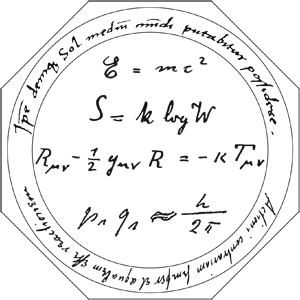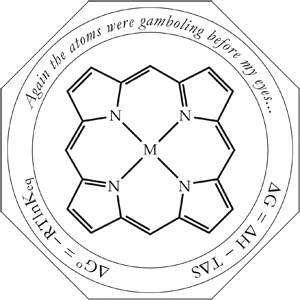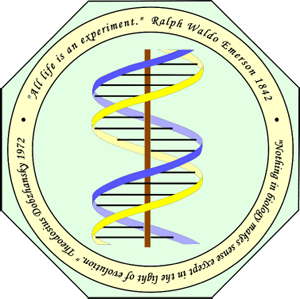Our brand new science building has a long hallway with clerestory windows and wonderful overlooks of the hallway from the labs on the upper floors. The terrazzo floor, however, needs some decoration, so each of the three departments involved in the project has been asked to design a four-foot octagonal medallion that will be set in the floor. The machine being used to do this is quite impressive; it can take vector graphics files and laser-cut those designs into the terrazzo. After the cutting procedure, terrazzo of other colors will be set into the cut-out sections.
So imagine yourself tasked with designing a floor medallion that succinctly describes your field, entices like-minded undergraduates to join your discipline, and most importantly – stands the test of time. These medallions are literally going to be set in stone, and we don’t want a scientific fad (or an actual error) made permanent. Here are the current designs:
The physicists have taken a set of fundamental equations in the hands of the original authors:

Around the top is a quote from Copernicus’ De revolutionibus which says in translation "And we can see that the sun is in the center". Around the bottom is Newton’s 3rd law, " For every action there is an equal and opposite reaction" (Actioni contrarium semper & æqualem esse reactionem) which was taken from lectures Newton deposited in Cambridge as part of his Lucasian professorship. The equations in the center of the medallion are:
- Einstein’s famous energy-mass equivalence that was a direct consequence of his 1905 paper Does the inertia of a body depend upon its energy-content?. This is one of the Annus Mirabilis papers that are celebrating their centenary this year.
- Boltzmann‘s fundamental equivalence between available microstates of a system (W) and the Entropy (S) which has become the foundation of statistical mechanics. Boltzmann’s grave in the Zentralfriedhof in Vienna also displays this formula.
- Another equation from Einstein. This one covers General Relativity, relating the curvature of spacetime (Left)
to the Energy Density (stress-energy tensor) (right). - The Heisenberg uncertainty principle. I particularly love this equation because it shows a wonderful meta-uncertainty. Heisenberg replaces the equality with an approximate equality in the manuscript, and then in published work shows that the product of the variance in momentum and position is actually greater than or equal to a constant.

The chemists (and biochemists) start with the porphyrin ring system with a bound, but unspecified metal atom. This chemical motif can be found in chlorophyll (with a reduced pyrrole unit and a bound Magnesium atom in the M position) as well as in heme (with a bound iron in the M position). This is an organic molecule (which makes my organic colleagues happy), with a bound metal (which makes the inorganic chemists happy), and is a fundamental structure in two biochemical processes (which makes the biochemists happy). The other three groups have tried to mollify the physical chemists with two equations: one defining the Gibbs free energy, and one relating free energy changes to the equilibrium constant. Personally, I would have preferred the UV-Vis spectrum of porphyrin as the representative contribution of physical chemistry.
The quote along the top is the beginning of Kekulé‘s description of his dream about the benzene structure:
…I was sitting writing on my textbook, but the work did not progress; my thoughts were elsewhere. I turned my chair to the fire and dozed. Again the atoms were gamboling before my eyes. This time the smaller groups kept modestly in the background. My mental eye, rendered more acute by the repeated visions of the kind, could now distinguish larger structures of manifold conformation; long rows sometimes more closely fitted together all twining and twisting in snake-like motion. But look! What was that? One of the snakes had seized hold of its own tail, and the form whirled mockingly before my eyes. As if by a flash of lightning I awoke; and this time also I spent the rest of the night in working out the consequences of the hypothesis.

The biologists had an easier time picking a single image to summarize their field. The DNA double helix is so important in biology that it had to be the central image. The two quotes they chose are wonderful, however:
- "All life is an experiment" from a journal entry (November 11, 1842) by Ralph Waldo Emerson
- "Nothing in biology makes sense except in the light of evolution." which was the title of a talk delivered by Theodosius Dobzhansky at the 1972 meeting of the American Association of Biology Teachers.
Well, there you have it. This is what three argumentative groups of scientists want set in stone about our three fields, and as a corollary, what we want our students walking all over with snow- and mud-covered boots. Although the chemistry medallion feels like it was designed by committee (which it was), chemists belong to a very broad field that barely speaks the same language from one side to another. I’m amazed we could come to agreement on any design.
[tags]science, floors[/tags]

Hello! Where are those nice medallions to be seen? Where is this science building! I work on porphyrins and I like the chemists medallion very much! Is it already built?
Daniel
Daniel,
The medallions are in the Jordan Hall of Science at the University of Notre Dame. If you live anywhere nearby, the facility is fantastic and is worth a tour. They give tours of it during home football weekends.
Hi Dan
do you happen to have a high res version of Physics medallion. I absolutely love the original handwriting and can’t seem to find each and every one of them online.
thanks
Stephan